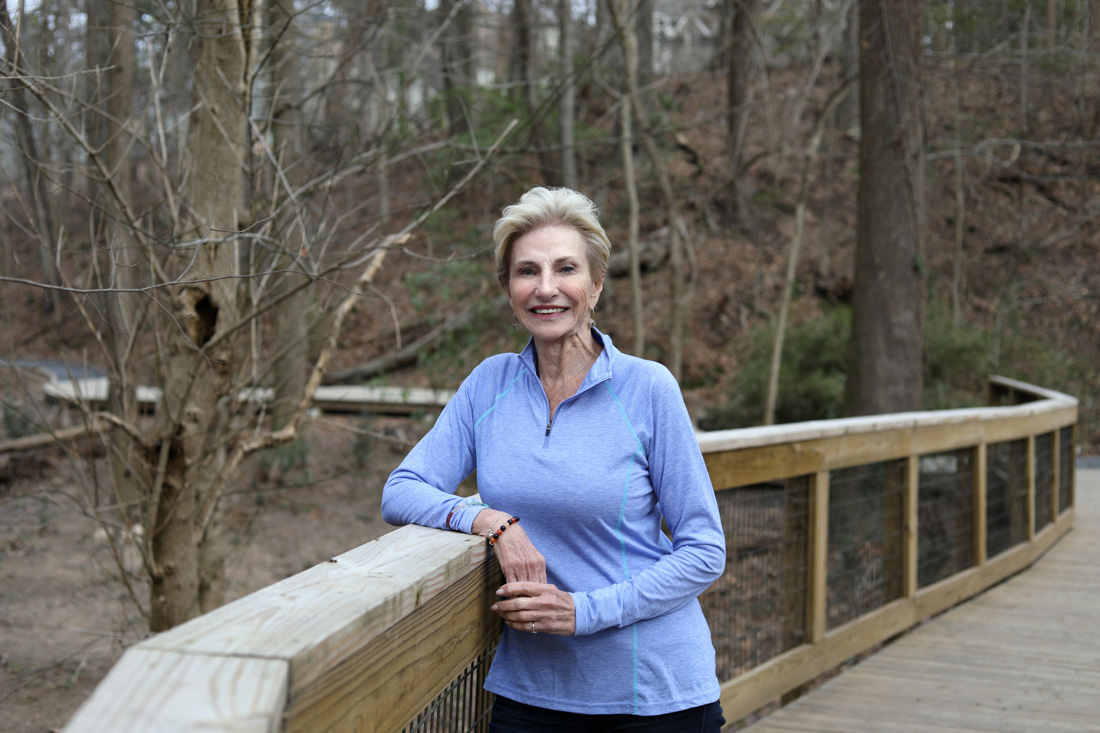A walk through the Japanese art of “forest bathing” with guide Phyllis Abramson
Walking is my drug of choice,” says Phyllis Abramson, founder of My Forest Bathing, who leads groups and individuals on specialized nature hikes in Buckhead and beyond.
Abramson was drawn to the practice of Japanese Shinrin-Yoku, which translates to “forest bathing,” for its multitude of proven mental and physical benefits. “I’m just the guide; the forest does the therapy,” she notes.
A former registered nurse and retired marriage and family therapist, for the last three years, Abramson has turned her healthy sights to leading these nature walks, including within Buckhead’s Blue Heron Nature Preserve. The avid walker, who first discovered her love of nature growing up in upstate New York, is both a Certified Nature and Forest Therapy Guide through the Association of Nature and Forest Therapy Guides and National Outdoor Leadership School (NOLS) Wilderness First Aid Certified.
Here, Abramson explains what forest bathing is and why we should consider trading our movie habit for the great outdoors.
Where did the idea of forest bathing come from?
Shinrin-Yoku was started by Japan’s Ministry of Health in the 1980s. The purpose was to help the Japanese with stress relief by prescribing them time in nature. There are now designated Shinrin-Yoku forests and guides in Japan. The concept was brought to the U.S. in 2014, and I was the 101st guide trained here! It is now in 41 countries and gaining in popularity.
What is forest bathing exactly?
It is a walk in a natural setting such as a forest or gardens at a very slow pace and in silence, taking time to observe everything around you and using all five senses. It’s all about getting out of your busy mind and being in the moment.
What kinds of health benefits do the trees themselves offer?
Trees give off phytoncides, a kind of forest aroma that includes the terpenes limonene (think of citrus trees) and pinene (think of pine trees). These are antimicrobial compounds and help trees protect themselves. For humans, there are so many studies on the calming effects that trees’ phytoncides have. They are linked to reduction in cortisol [stress hormone] levels and blood pressure, as well as increased mental focus and attention.
What does a walk entail?
My guided walks are typically a 2- to 3-hour experience. We begin by sitting in a circle on camping chairs, and I first explain what forest bathing is. Throughout our time together, we will go walking and then come back together to discuss what we’ve observed. I’ll offer the group or individual a series of invitations in between each walk. These may be to close your eyes and pay attention to what you hear coming from different directions or to walk, stepping very gently on the earth. It’s very meditative.
How can people incorporate forest bathing into their regular lives?
Choose it as a birthday activity instead of a night out. Don’t go to a movie with your family; go to a forest!
MY FOREST BATHING
myforestbathing.com
PHOTO: Sara Hanna
Managing Editor and Wellness Columnist at Simply Buckhead. Blogger at Badass + Healthy.










